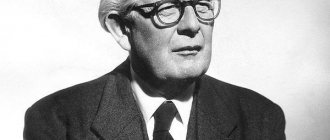The development of a person’s personality takes place in several psychological stages. Each of them has its own characteristics, each stage is marked by a conflict specific to it. The continuity of development of our “I” remains unchanged, despite the changes that occur to us in the process of growth.
In classical psychoanalysis, according to the theory of psychosocial personality development created by Professor Erik Erikson, it is customary to distinguish eight stages: infancy, early childhood, preschool and school age, adolescence, young adulthood, maturity and old age. Let us pay attention to the accents noted in each of them.
What does "ego" mean?
First you need to understand what the ego is. This term is most often used in psychoanalysis. The ego is the inner essence of a person, responsible for perception, memorization, contacts with society and evaluation of the world around us. This helps a person to separate himself from everything else, to accept himself as an independent and individual being.
Is ego good or bad?
The human ego is an important component of personality structure. Without it, the existence of man as such is impossible. It does not matter whether the Ego is male or female, it helps to perceive the external world and analyze it from the point of view of importance for a person. Thanks to the inner “I”, each individual adapts to the world, finds his place and calling, and comes into contact with the people around him.
Whether it is good or bad to have your own Ego can only be discussed from the perspective of the level of development of this substance and the dominant functions it has assumed. If the world around us is perceived only as a platform for satisfying our own needs, then we can say that the Ego is developed at a weak level. A highly developed “I” strives to be part of the world, therefore it takes into account not only personal interests, but also the interests of others.
Definitions of identity
In psychology, ego identity is a multifaceted concept. When talking about it, the concepts of identity and identification are also mentioned. Thus, B. G. Meshcheryakov and V. P. Zinchenko in the “Psychological Dictionary” propose to consider the following definitions.
- Regarding cognitive processes, this is the establishment of the identity of an object, its recognition.
- From the point of view of psychoanalysis, identity is a process built on the basis of emotional connections. Thanks to them, a person acts as if he is the person with whom he compares himself.
- In social psychology, identification is the process of identifying oneself with another person.
- This is imagining oneself as a fictional character, which results in a deeper understanding of the work of art.
- This is the attribution of one's thoughts, motives, feelings and traits to another person.
- This is one of the types of psychological defense, which consists of unconsciously assimilating something that causes anxiety or fear.
- According to the theory of “Self-concept”, group ego identity is an identity in which a person identifies himself with a social group, large or small community, accepting its goals and values, considering himself a member.
- Identity is also the property of the psyche to express the idea of belonging to various national, linguistic, racial, social, religious, economic, political, professional and other groups that have certain properties.
Thus, a general definition can be formulated. In psychology, ego identity is the continuity and identity of the “I”, the integrity of the personality, which is preserved despite the changes that occur in the process of its development and growth. That is, as a person grows older, he understands that he remains the same, himself.
Ego Defense Mechanisms
The founder of the theory of defense mechanisms is S. Freud. In scientific works, he spoke about defense mechanisms as a means of protecting the psyche from the pressure of the Id and Super-Ego. These mechanisms work at the subconscious level and lead to a distortion of reality. Freud identified the following ego defenses:
- repression – removal from memory of information that traumatizes the psyche or is unpleasant;
- projection - transferring thoughts and desires to another person;
- replacement - transferring a negative reaction from one person who caused the reaction to another;
- rationalization - explaining unacceptable behavior from a logical point of view in such a way that the behavior begins to seem acceptable or the only possible one;
- regression - a return to behavior characteristic of a younger age;
- sublimation – redirection of impulses that cause discomfort into socially approved activities;
- reactive formation is a manifestation of behavior that is directly opposite to the desires that a person has;
- Denial – refusal to acknowledge unpleasant events or thoughts.
E. Erickson's concept
In general, the term “ego identity” itself was introduced into science by the German psychologist Erik Erikson. Based on Freud's theories, he developed his own concept, which had significant differences. Attention was focused on age periods.
According to Erikson, the ego's job is to ensure the normal development of the personality. “I” is capable of self-improvement throughout life, helping to cope with internal conflicts and correcting the incorrect formation of the psyche. Although Erickson views the ego as a separate substance, he at the same time believes that it is inextricably linked with the social and somatic part of the personality.
The scientist in his theory pays special attention to the period of childhood. This period of time allows a person to develop mentally and get a good start for further self-improvement. Erikson believes that there is a significant flaw in the childhood period. This is a baggage of irrational fears, anxieties and experiences that directly affect the quality of subsequent development.
The main concept in the theory is ego identity, in other words, the integrity of the individual. Its formation begins from birth and continues throughout life, right up to the death of a person. Erikson identifies a total of eight stages of psychosocial development. If a person passes them successfully, a full-fledged functional personality is formed.
Each stage is accompanied by a crisis. By it, Erikson understands the moment that arises as a consequence of achieving a certain stage of psychological maturity and the accompanying social demands that are put forward to the individual at one or another phase of development. An ego identity crisis is the risk of losing it. If the conflict is not resolved, the ego is injured and harmed. Then identity, integrity and belief in one’s own social role decrease or even disappear. But there is also a positive component to the crisis. If the conflict is resolved satisfactorily, the ego receives a new positive quality that guarantees healthy personality formation in the future.
That is, it is necessary that the close group and society contribute to the adequate passage of each identity crisis. Only then will a person be able to fully move on to the next phases of self-improvement.
All eight stages will be discussed separately below. These are infancy, early childhood, play, school age, adolescence, early, middle and late adulthood.
Personality theories
. . .
Erikson's theory has had a major influence on developmental psychology (Papalia & Olds, 1986; Santrock, 1985). His ideas have found application in early childhood education, vocational counseling, social service, and business.
It should also be noted that Erickson conducted extensive psychohistorical research on such famous figures as Martin Luther, Adolf Hitler, Mahatma Gandhi and George Bernard Shaw.
Psychohistory –
it is a form of research that attempts to relate the major themes of a person's life to historical events and circumstances (Crosby and Crosby, 1981; Runyan, 1982).
The recent increase in interest among personologists in biographical and autobiographical methods of studying personality is largely due to Erikson's work on psychohistory (Moraitis, Pollack, 1987).
Despite its popularity, Erikson's theory has not generated an impressive amount of empirical research. Part of the lack of systematic research on this theory can be explained by the fact that its ideas are complex and abstract.
Moreover, concepts such as trust, fidelity, and psychosocial moratorium are not defined so clearly that their empirical validity can be established.
Another difficulty arises from the fact that validating Erikson's theory requires extensive longitudinal studies to assess developmental changes throughout the life cycle. Collecting longitudinal data is an expensive and very time-consuming procedure.
As a result of all this, studies devoted to testing the characteristics of the mutual influence of psychosocial stages are now relatively rare. Finally, Erikson himself showed no interest in empirically testing his propositions. The research he himself conducted was based on meaningful analysis of clinical cases.
However, some concepts in psychosocial theory are certainly amenable to rigorous research.
For example, Erikson developed criteria for psychosocial health and illness for each crisis period, using behavioral characteristics that were sufficiently clearly defined, which allows direct study of how the resolution of a previous crisis manifests itself in current behavior and attitudes.
Erikson's theory also seems suitable for empirical testing because it deals with social indicators of development, as opposed to those theories that focus on intrapsychic processes.
Finally, Erikson made possible a rigorously consistent study of relevant psychosocial phenomena in individual development, whereas other theories often lack such a synthesis of developmental issues. However, until carefully designed studies produce satisfactory results, the empirical status of Erikson's theory will remain unclear.
Although Erikson did not see the need to empirically test his theory, other researchers tried to do so. Let's look at a few examples of such studies.
Ego Identity Research
As noted above, of all the psychosocial stages of the life cycle, Erikson (1968a) paid the most attention to adolescence. Our review shows that the majority of studies published to date focus almost exclusively on this phase.
Marcia (1966, 1967, 1980) conducted several studies examining the antecedents and consequences of identity formation in adolescents.
Based on the work of Erikson, they identified four independent orientations, or ego identity statuses
: 1) diffusion of identity; 2) predetermination; 3) moratorium; 4) achieving identity. These states (as shown in Table.
5-2) are described using two independent parameters, namely, the crisis and such a circumstance as making commitments in two main areas of functioning: professional activity and ideology (that is, religion and politics).
Term crisis
refers to that period of great effort in a person's life when he is considering what career to choose and what beliefs and values to follow in life.
Commitment
involves making firm decisions regarding the choice of profession and ideology, as well as developing targeted strategies for implementing the decisions made. An individual's ego identity status is determined by assessing his responses to a standardized interview developed by Marcia (1966).
Table 5-2. Marcia's Four Ego Identity Statuses
Each square of the matrix is completed by exploring the crisis and commitment process through a semi-structured interview regarding career choice and ideology.
| Will the crisis survive? | |||
| Yes | No | ||
| Has a decision been made? | Yes | Achieving Identity | Foregone conclusion |
| No | Moratorium | Diffusion of identity |
Diffusion of identity
characterized by “burdened by a lack of obligations.” An individual with identity diffusion may or may not experience a crisis, but in any case, there is a minimum or even absence of values and roles accepted by the individual, and the absence of a cherished dream.
Predetermination –
the state of a young man or girl who has already established his basic orientations. However, there are no signs (or very few) that they were experiencing a crisis.
An example of a “predetermined identity” would be a college student who decides to become a dentist because that is the profession of his father and grandfather.
Moratorium status
on identity assumes that a person is currently in a state of crisis (chooses between alternatives), and his preferences are too weak and uncertain.
A college student who sees herself in the future as a chemist, a minister, or a journalist is an example that illustrates the state of persistent and prolonged internal struggle with the uncertainty of choice characteristic of this status. Finally, identity achievement
refers to people who have experienced a period of crisis and have made certain choices regarding professional and ideological goals and positions.
The existence of these four ego identity statuses now has much empirical support (Bourne, 1978; Marcia, 1980). In addition, many studies have been conducted that have examined the connection between the described identity statuses and patterns of relationships in the family.
This line of research, summarized by authors such as Marcia (1980) and Waterman (1982), has shown that individuals with a predetermined ego identity have warmer relationships with parents than those with other ego identity statuses.
Subjects with “predeterminism” are also more likely than others to turn to their families for advice and support in situations where they need to make vital decisions. As a result, they do not have to “struggle” as hard to achieve an identity; they largely manage to avoid critical analysis of the long-term consequences of possible final decisions.
On the contrary, people in a state of moratorium, as well as identity achievement, do not tend to seek advice from their parents in important cases. They appear to be more critical of their parents and have higher levels of conflict in their parental families.
Individuals with a diffuse identity report the greatest distance between themselves and their parents. These teenagers perceive their parents as indifferent to them, rejecting them, and therefore they lack the role models characteristic of teenagers with “predeterminism”.
There has been considerable interest in studying the relationships between identity status, motivation to learn, and academic performance in college students.
Research results show that those who have achieved an identity consider such disciplines as mathematics, biology, chemistry and engineering to be their main disciplines, while students with a diffuse identity are more attracted to sociology, teaching and physical education (Adams, Fitch, 1983; Marcia, Friedman , 1970).
A similar study (Waterman, Waterman, 1970) showed that students who had decided on their career choice had a more positive assessment of their studies and everything connected with it than students who had not yet decided what they would do after graduating from college.
Students who achieve ego identity receive higher grades than others (Cross and Allen, 1970). Finally, one particularly interesting study (Marcia, 1967) found that students with a strong identity experience less dramatic (as measured by self-esteem) failures on tasks that affect academic performance.
Another study examined the links between ego identity status and social influence processes. Thus, students with a diffuse identity demonstrated the greatest conformity under peer group pressure (Adams et al., 1985).
Those who achieved identity also showed a willingness to behave conformally in similar situations, but only when this led to the achievement of certain goals.
This is exactly the kind of display of sensitivity to the opinions of others that can be expected from a person who is confident in his ego identity.
Exploring the achievement of identity and the capacity for intimacy later
According to Erikson's epigenetic theory of psychosocial development, successful resolution of each conflict allows the individual to cope with the next stage (and the next conflict) with a more positive orientation.
Namely, a strong sense of identity makes it easier for the maturing individual to develop the capacity for intimacy. A study conducted by Kahn et al. (Kahn et al.
, 1985), aimed to experimentally test the idea that the acquisition of a stable identity in early adulthood is likely to lead to the achievement of intimacy in middle age.
To this end, scientists in 1963 studied identity using the self-assessment method in groups of sophomores and freshmen in an art school.
In 1981, 60% of participants in the first study filled out a questionnaire containing questions about their personal, family and professional lives after graduation. Marital status was chosen as an indicator of intimacy. The subjects were asked to choose one of the following categories: never married (was not married), married (married), living separately from my wife (husband), divorced (divorced), widower (widow). The second question concerned the number of divorces, if any.
The results were consistent with the theory: a strong connection was found between the achievement of ego identity and the ability to be intimate in adulthood. However, gender differences overlapped with the general pattern.
With regard to the prediction of intimacy (marriage) in men based on ego identity, those who were identified as having a strong identity in 1963 had significantly stronger marital relationships 18 years later. Only one in 35 high-identity men was unmarried by 1981.
For women, on the contrary, marital status did not depend on identity achievement. However, among married women, a strong relationship was found between identity and marital stability. In fact, more than two-thirds of low-identity women reported marital breakdown during those 18 years.
There were no differences in the identity parameter between men in stable and unstable marriages. The authors suggested that the ways in which intimacy is achieved may be different for both sexes.
“For men, achieving intimacy is closely related to the decision: to marry or not to marry. In this regard, achieving an identity based on traditional male role characteristics such as instrumentality, goal-directedness and competence is crucial.
On the other hand, women may be bound by social pressures to get married, so achieving identity has little to do with marriage. At the same time, achieving intimacy among married women apparently affects the stability of marital relationships.
Apparently, an identity based on the ability to cope with anxiety and the ability to express one's feelings openly contributes to marital stability” (Kahn et al., 1985, p. 1321).
Overall, the results obtained in this study indicate that there are different patterns of identity formation between men and women. The resulting differences, in turn, indicate the need to create new models that describe specifically the female version of development (Gilligan, 1982).
Source: //bookap.info/genpsy/terlich2/gl52.shtm
Infancy
The formation of ego identity occurs already in infancy. This stage of development conventionally lasts from birth to one year. During this time period, the baby goes through a crisis of basal trust-distrust. If the mother and other close environment during infancy do not provide the child with enough attention, love and care, then he will develop qualities such as suspicion and timidity. Moreover, they will manifest themselves and make themselves felt even during adulthood. If the mother cares enough for the baby and shows love, then he will subsequently begin to trust people and the world as a whole. The environment will be perceived in a positive way. Usually we can talk about a favorable passage of the crisis if the child calmly tolerates the disappearance of the mother from sight. Because he knows that she will come back again and take care of him.
That is, as an adult, a person will trust or distrust society in the same way as he trusted or distrusted his mother in infancy. However, this quality continues to develop at subsequent stages. For example, when a child witnesses the divorce of constantly conflicting parents, the previously acquired basal trust may be lost.
How to acquire an Ego?
The human ego is born along with the appearance of the individual in this world. During life, it can change direction, degenerating from the selfish Self into the higher one. The male and female Ego demands the attention of the whole world, since it considers itself the center of the Universe. Religions of different nations agree that it is almost impossible to overcome the innate selfish Ego on your own. It can only be dealt with with the help of supernatural divine power. You can acquire a higher self through constant spiritual practices, reading spiritual literature and self-improvement.
Early childhood
Lasts from one to three years. At this stage, the crisis moment of ego identity manifests itself in the formation of autonomy or doubt and shame.
In early childhood, the baby develops mental and motor needs that promote independence. The child learns to walk, master the subject environment and do everything without anyone’s help. If parents give such an opportunity, providing freedom, then the child’s confidence is strengthened that he controls himself, his impulses, muscles and environment. So he gradually becomes independent.
Sometimes adults are in a hurry and try to do for a child something that he himself could handle perfectly well without their help. As a result, the child develops such qualities as indecisiveness and shyness. Naturally, they negatively affect later life. Therefore, it is important for parents to be patient and give the child the opportunity to do something on his own.
Use in economics
Elements of a brand’s identity are its attributes (Brand Identify). For example, a brand signature (English Brand Signature): symbol (English Brand Mark), logo (English Brand Logotype), brand slogan (English Brandline or English Brand Slogan), graphics supporting the brand (English Supergraphic).
Brand identity - (eng. Brand Identity). Distinctive features of the brand, its individuality (Brand Personality). The metaphor of brand identity is the “DNA” of the brand. It has several definitions: 1) the strategic concept of the brand’s personality, its external expression, the totality of its identifiers; reflection of characteristics unique to the brand that motivate the buyer; plays a key role in the process of brand recognition by consumers; forms its uniqueness; is the main element of the motivational vertical of brand management, participating in the formation of the brand model and image; 2) what the brand represents in the perception of consumers or as intended by its developers. There is a term “brand attributes” (English: Brand Identify or english: Brand Attributes).
Corporate identity - (English Сorporate Identity), expressed in the attributes of corporate style (English Сorporate style). Same as brand identity, but in relation to a corporate brand. A corporate brand is associated with the company name (and/or its symbol) and can be used for the company's products. It is often the basis or complement for a family brand (English Family Brand) and individual brand (English Individual Brand); In the Asian model of brand management, the corporate brand plays a central role: most subsidiaries, products and services have one brand, which may change, but only slightly. T.N. Monolithic brand or Branded House
In this case, advertising focuses not on product brands, but on the corporate brand: the main advantage is focusing activities on the unity of the company and common corporate values, which in turn allows you to quickly build a global business structure, but is associated with various risks and difficulties during diversification production. In the Western model of brand management, the emphasis is on brands owned by the company, and the corporate brand is assigned a supporting role in the event of the success of products/product categories under independent brands (English: House of Brand)
The modern brand management model uses a combined approach that takes advantage of Asian and Western models. There is also the concept of corporate branding.
National identity - (English National Identity, see Territorial identity). The concept of related sciences in brand management is associated with the terms “national branding”, “territorial branding” or “territory branding” (Wally Olins). Denotes the identity of a national or territorial (regional, country, etc.) brand. For more information, see Brand Identity and National or Territorial Co-Branding.
"Game Age"
Lasts approximately three to six years. During this period, the formation of ego identity can take the path of initiative or guilt.
At preschool age, children usually already do a lot on their own, show enterprise and activity, and strive to communicate with a wide range of people. If parents encourage this, do not interfere with fantasizing and answer the child’s endless questions, then he will go through an identity crisis favorably at this stage.
If adults constantly pull the child back, forbid him to ask anything, invent anything, and arrange noisy games, then he begins to feel guilty, his own worthlessness and loneliness. Subsequently, this can develop into a pathology, perpetuating passivity, psychopathic behavior and even frigidity (or impotence) in the child. Children who have not overcome the crisis at this stage become dependent, driven, and indecisive. They cannot stand up for themselves and do not strive for anything.
Problems of multiculturalism
Proponents of political liberalism in the late 1980s and early 1990s believed that rights should be neutral in relation to gender, culture, etc. - that is, equality should not depend on identities. But debate in normative political theory has shown that such neutrality is impossible, and various scholars have argued that we cannot be insensitive to many requests for recognition. For example, in the case of the American Indians, who were oppressed and for whom acceptance as a distinct group is of fundamental value. But progressive measures in this area also entail new problems.
In Canada, the Multiculturalism Act was passed in 1971. It turned out that if we give Indian closed communities some autonomy and the opportunity to determine for themselves who they are, this does not mean at all that such a situation will give rise to further tolerance. Women's rights may not be respected in these communities; these communities may be closed to outsiders and mixed marriages.
When we try to make a progressive gesture and assign individuals to an identity, give them rights or privileges according to that identity, we deprive them of autonomy.
School age
This stage is conventionally equated to the age of 6-12 years. At this stage of their life, children begin to learn, try handicrafts, design and build something. They often fantasize about different professions.
Here, the favorable development of ego identity presupposes the presence of social approval. If a child is praised for creativity and activity, this will help develop abilities and become hardworking. If parents and teachers do not do this, then this will contribute to the formation of inferiority. At this stage, the student’s identity can be represented by the phrase: “I am what I was able to learn.”
“Identity” in politics and analytics
In everyday life, the meaning of the term “identity” seems to be beyond doubt: everyone should have some kind of identity. However, there are two ways to use this concept.
The first is the language of political practice, in which it has been used since about the mid-1990s. When politicians talk about identity, their task is to convince that each group they address has a special commonality and solidarity, and internal differences do not matter.
Brubaker believes that there are two groups of interpretations of “identity.” One can be called rigid, or essentialist (from the English essence - “essence”): it is assumed that each person’s identity is predetermined, inherent to him initially as a representative of a certain group, even if he is not aware of it. It seems to me that this approach dominates in Russian political language.
Brubaker calls the second group of interpretations soft, or constructivist; this language of speaking about identity was formed by the 1990s. According to such approaches, a person lives in some new social and information space, belongs to many social worlds, and depending on the context, his idea of himself is constantly being transformed. Identity is something fluid, flexible, plastic, elusive - a certain set of categories, a language that does not reflect what a person already has, but works in a performative manner. A person initially does not think that he has any identity, but by accepting a certain language, he begins to become aware of himself in a certain way.
stocksnapper
period of youth
He is aged 12-19 years. This is a time of active physiological changes, striving to find your own philosophy of life and look at the world around you in your own way. The teenager begins to ask questions such as “who am I?”, “who do I want to become?”
The most complete form of ego identity is formed at the age of 12-19 years. It is also at this stage that the deepest crisis begins. If it cannot be overcome, then role confusion will occur. It can be characterized by restlessness and disorientation in oneself. Therefore, it is important to help a teenager create a consistent and unified image of himself. After all, it was this period that Erikson considered the most central in the development of social and psychological well-being.
True and false ego
The category of true and false Ega does not relate to psychology, but stems from the teachings described in the ancient Indian books - the Vedas. In these manuscripts one can find a different understanding of what the Ego is. According to this teaching, the false ego is a substance that helps a person perceive and live in the physical world. This force evokes in a person those desires and impulses that are necessary for the survival and comfort of himself and those close to him. For this reason, this substance is also called egoism.
The true Ego goes beyond personality and self-interest, helps to pay attention to the world around us, feel its problems, and help people. Life, which is based on actions and thoughts emanating from the true Self, becomes bright and pure. It is impossible to overcome selfishness and live following the true “I” on your own. The basis of such a life is the highest love for God.
Early maturity
The age of 20-25 is a kind of gateway to a new adult life, as Erickson himself said. As a rule, during this period people get a profession, date the opposite sex, and sometimes get married.
Whether there will be a failure or a positive outcome at this stage directly depends on the success of completing all previous stages. If the identity crisis is overcome, then a person will be able to take care of another individual, will love and respect him, without fear of losing himself. This is what scientists call achieving closeness (intimacy). If the ego-identity develops unfavorably at this stage, the person isolates himself. He will become lonely, with no one to care for and no one to share his life with.
Notes
- Wed. also Onto In-se in the terminology of ontopsychology
- Zinchenko V. P., Meshcheryakov B. G.
Psychological Dictionary. - 2nd. - M.: Pedagogika-Press, 1999. - 440 p. — ISBN 5-7155-0720-0. - Litvinov N. N. Brand culture: winning the client’s favor (Brand Manager Handbook). // Brand management. — 2007. — No. 5(36) — pp. 338–343.
- English-Russian explanatory dictionary. Marketing and trade. - M.: Economic School, OLMA-PRESS Education, 2005. - 83 p.
- Rudaya E. A. Fundamentals of brand management. - M.: Aspect Press, 2006.
- Litvinov N. N. Brand strategy of territories. Algorithm for searching for national identity (part 1) // Brand management. - 2010. - No. 4 (53). — pp. 244–255.
- Speech communication: Problems and prospects: Sat. scientific-analytical reviews. M., 1983, p. 192-193.
Average maturity
This is a very broad period that covers the age range from 26 to 64 years. Here, the essence of the crisis is the choice between self-absorption (inertia) and productivity (focus on humanity). In the second case, a person gets a job or does something that allows him to take care of the future of society. If a person remains inert, then he focuses only on himself, on his own comfort, satisfaction of his needs and requirements. It would seem that for the era of global consumption this should be considered the norm. However, having chosen such a pole, a person often feels the meaninglessness of life.
How to pacify your Ego?
The fight against one’s own self is one of the most difficult tasks of every individual. If a person has an Ego inflated by passions, anger, envy, material desires, then he will have to fight long and hard with this part of his personality. The first thing you need to pacify your Ego is the realization that it is selfish, inferior. You should understand where it leads, recognize all your aspirations, desires, motives and motivations. After this, you need to choose a way in which you can work on your Ego. To do this, you can use spiritual practices or psychological programs to work on yourself.
Late maturity
This is the last stage of ego identity development according to Erikson. It lasts from 65 years until death. At this age, old age begins, which is considered the most favorable time for reflection, summing up, analyzing failures and achievements. A person can understand that he did not live his life in vain, he succeeded in everything, and everything suits him. Erickson called this awareness a sense of ego integrity. It can be considered a favorable overcoming of the crisis.
However, some old people are beginning to despair because of the summed up results. They are overcome by a feeling of hopelessness because they have not used all the opportunities or corrected some mistakes. They come to the conclusion that their life was completely meaningless. It is in this situation that people are very afraid of the impending inevitable death. In this case, it’s not too late to rethink everything and do something really necessary and useful.
Books about Ego
A huge amount of information about the inner self is collected in the following books:
- Z. Freud “I and It”
. The book examines the power of the Ego, its meaning and connection with the unconscious and conscious side of the psyche. - A. Freud “Psychology of the Self and Defense Mechanisms”
. In addition to reflections on the components of the psyche, the book contains a detailed description of defense mechanisms. - E. Erikson "Identity and the life cycle"
. The book describes in detail the central concept of Erikson's psychology - identity. - E. Gar
. In his work, the author tried to combine different ideas about the unconscious and his own Ego.
conclusions
Erik Erikson, having developed the concept of Sigmund Freud, developed his own unique theory. It focuses on the formation of a conscious, full-fledged personality. He was also the first to formulate a definition of the term “ego identity.” In psychology, this is the integrity of the individual, which develops from birth to death. It is customary to distinguish eight stages of identity formation, each of which is accompanied by a certain crisis. The success of overcoming them determines whether a person will perceive himself as an integral, full-fledged individual or not. Parental education plays the main role in the formation of this quality. At subsequent stages of development, the environment begins to influence.
Freud and Erikson: theoretical differences
Erikson himself insisted that his concepts were nothing more than a continuation of Freud's psychoanalytic theory. But in fact, he moved so far away from it that in modern science Erikson’s theory is considered separately. What is the difference between the views of Freud and Erikson on personality development, human character and its formation in the process of life?
- Freud gave the main role in personality development to unconscious drives, or Id. He was convinced that it was the conflict between the unconscious and social restrictions that was the cause of all diseases and neuroses. Erikson insisted on the dominant role of the ego, due to which Erikson’s theory was called “Ego psychology.” Freud believed that the Ego is a component that, as if between a rock and a hard place, is trying to reduce the restrictions of society and the drives of the Id. Erickson believed that the ego is a separately functioning system that works with the outside world through perception, thinking, memory and attention.
- Freud's and Erikson's views on the parental role in character formation differ. The development of personality is influenced to a greater extent by the conditions in which a person was born and lives, and the historical era. Erikson came to this conclusion by observing the development of children in different cultures. The scientist was sure that the Ego inevitably develops and changes under the influence of external conditions.
Erikson's theory of personality development differs from Freud's concept in understanding psychosexual conflicts
Freud focused on the influence the unconscious has on human life. He also believed that unresolved childhood traumas were the cause of adult conflicts.
Erikson, on the contrary, placed the main emphasis on understanding the adult as an individual who can cope with difficulties. His theory is centered on the concept of the Ego with all its virtues, which are revealed in the process of life.










